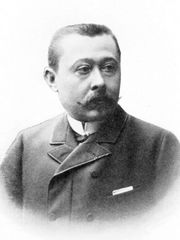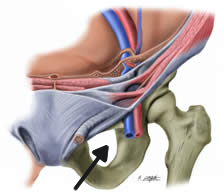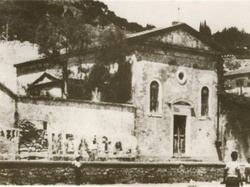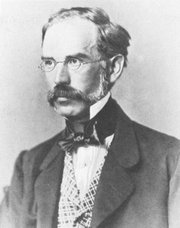
Medical Terminology Daily (MTD) is a blog sponsored by Clinical Anatomy Associates, Inc. as a service to the medical community. We post anatomical, medical or surgical terms, their meaning and usage, as well as biographical notes on anatomists, surgeons, and researchers through the ages. Be warned that some of the images used depict human anatomical specimens.
You are welcome to submit questions and suggestions using our "Contact Us" form. The information on this blog follows the terms on our "Privacy and Security Statement" and cannot be construed as medical guidance or instructions for treatment.
We have 1273 guests online

Jean George Bachmann
(1877 – 1959)
French physician–physiologist whose experimental work in the early twentieth century provided the first clear functional description of a preferential interatrial conduction pathway. This structure, eponymically named “Bachmann’s bundle”, plays a central role in normal atrial activation and in the pathophysiology of interatrial block and atrial arrhythmias.
As a young man, Bachmann served as a merchant sailor, crossing the Atlantic multiple times. He emigrated to the United States in 1902 and earned his medical degree at the top of his class from Jefferson Medical College in Philadelphia in 1907. He stayed at this Medical College as a demonstrator and physiologist. In 1910, he joined Emory University in Atlanta. Between 1917 -1918 he served as a medical officer in the US Army. He retired from Emory in 1947 and continued his private medical practice until his death in 1959.
On the personal side, Bachmann was a man of many talents: a polyglot, he was fluent in German, French, Spanish and English. He was a chef in his own right and occasionally worked as a chef in international hotels. In fact, he paid his tuition at Jefferson Medical College, working both as a chef and as a language tutor.
The intrinsic cardiac conduction system was a major focus of cardiovascular research in the late nineteenth and early twentieth centuries. The atrioventricular (AV) node was discovered and described by Sunao Tawara and Karl Albert Aschoff in 1906, and the sinoatrial node by Arthur Keith and Martin Flack in 1907.
While the connections that distribute the electrical impulse from the AV node to the ventricles were known through the works of Wilhelm His Jr, in 1893 and Jan Evangelista Purkinje in 1839, the mechanism by which electrical impulses spread between the atria remained uncertain.
In 1916 Bachmann published a paper titled “The Inter-Auricular Time Interval” in the American Journal of Physiology. Bachmann measured activation times between the right and left atria and demonstrated that interruption of a distinct anterior interatrial muscular band resulted in delayed left atrial activation. He concluded that this band constituted the principal route for rapid interatrial conduction.
Subsequent anatomical and electrophysiological studies confirmed the importance of the structure described by Bachmann, which came to bear his name. Bachmann’s bundle is now recognized as a key determinant of atrial activation patterns, and its dysfunction is associated with interatrial block, atrial fibrillation, and abnormal P-wave morphology. His work remains foundational in both basic cardiac anatomy and clinical electrophysiology.
Sources and references
1. Bachmann G. “The inter-auricular time interval”. Am J Physiol. 1916;41:309–320.
2. Hurst JW. “Profiles in Cardiology: Jean George Bachmann (1877–1959)”. Clin Cardiol. 1987;10:185–187.
3. Lemery R, Guiraudon G, Veinot JP. “Anatomic description of Bachmann’s bundle and its relation to the atrial septum”. Am J Cardiol. 2003;91:148–152.
4. "Remembering the canonical discoverers of the core components of the mammalian cardiac conduction system: Keith and Flack, Aschoff and Tawara, His, and Purkinje" Icilio Cavero and Henry Holzgrefe Advances in Physiology Education 2022 46:4, 549-579.
5. Knol WG, de Vos CB, Crijns HJGM, et al. “The Bachmann bundle and interatrial conduction” Heart Rhythm. 2019;16:127–133.
6. “Iatrogenic biatrial flutter. The role of the Bachmann’s bundle” Constán E.; García F., Linde, A.. Complejo Hospitalario de Jaén, Jaén. Spain
7. Keith A, Flack M. The form and nature of the muscular connections between the primary divisions of the vertebrate heart. J Anat Physiol 41: 172–189, 1907.
"Clinical Anatomy Associates, Inc., and the contributors of "Medical Terminology Daily" wish to thank all individuals who donate their bodies and tissues for the advancement of education and research”.
Click here for more information
- Details
Sylviane Déderix. Ph.D.
Dr. Sylviane Déderix is a Postdoctoral fellow at Catholic University of Louvain in the Aegean Interdisciplinary Studies Research Group. She has a Ph.D. in History, Art, and Archeology.
She is also a collaborator of the Laboratory of Geophysical- Satellite Remote Sensing & Archaeoenvironment and a member of the Sissi Archaeological Project (Crete, Greece) in charge of the architectural study of the house tombs excavated in the cemetery.
She has collaborated with the effort of finding the lost grave of Andreas Vesalius using satellite imagery and geophysical approaches to pinpoint the location of the cemetery of the Church of Santa Maria delle Grazie after the island of Zakynthos was practically destroyed by an earthquake in 1953.
Since then the island and its buildings have been rebuilt and streets relocated, which causes the cemetery to have been lost until her work was published. Now we know the approximate location of the cemetery close to the current intersection of the Kolokotroni and Kolyva streets, and further studies can be conducted.
Thanks to Dr. Déderix for collaborating with "Medical Terminology Daily" with the article "In Search of Andreas Vesalius, The Quest for the Lost Grave - The Sequel" which she co-authored with Pascale Pollier and Theo Dirix.
- Details
Article by Dr. Sylviane Déderix, Pascale Pollier, and Theo Dirix
From 4 until 8 September 2014, more than two hundred artists and scientists from more than 40 countries gathered on the Greek Island of Zakynthos to commemorate the quincentenary of the Flemish anatomist Andreas Vesalius who died on the island 450 years earlier. At this very moment when some start dreaming of a sequel of our Vesalius Continuum Conference, we continue to dream of the sequel of our search for his lost grave. The triennial of 2017 will be an ideal occasion to present a second phase in our search, on condition that the plan we are developing here succeeds.
The initial phase of the search for the Vesalius’s grave, started and presented in 2014, was based on recent re-examinations of historical sources that contest the traditional view that Vesalius was buried at Laganas. Research by the Flemish historians Omer Steeno, Maurits Biesbrouck, Theodoor Goddeeris and the local historical blogger Pavlos Plessas indeed suggest that the quest for his grave should rather focus on the town of Zakynthos, and more specifically on the courtyard of the church of Santa Maria delle Grazie.
Unfortunately, the small church was destroyed along with most of the buildings in Zakynthos during the major earthquake that struck the Ionian Islands in 1953. Its ruins were then buried when the town was reconstructed, and its exact location was soon forgotten. Material evidence, local informants and cartographic data nevertheless point in the same direction: the church of Santa Maria delle Grazie would have been located in the northern sector of the modern town, around the current junction of Kolokotroni and Kolyva streets.
In order to assess the validity of this hypothesis, we called on the services of Geographic Information Systems (abbreviated GIS). GIS are computer-based tools used for the management, analysis, and display of geographically referenced information. Within the framework of the quest for Vesalius’ lost grave, they were used to overlay historical maps on modern cartographic data. The procedure, which is named geo-referencing, allows registering individual maps in a common geographic space so as to define their position in the real world. In the present case, the goal was to geo-reference a town map dated to 1892 and on which the church can be identified. See the accompanying photograph of the church.
However, since the coastline and the town plan drastically changed after the earthquake, it was not possible to overlay the particular map directly onto modern satellite images: intermediary steps were necessary. The methodology consisted therefore in travelling back in time and geo-referencing three available maps from the most recent to the oldest. The result of the process confirmed that the ruins of the Santa Maria delle Grazie are to be found to the northwest of the intersection of the current Kolyva and Kolokotroni streets. The road that ran in front of the church in the late 19th and early 20th century followed a different orientation than Kolyva street, with the consequence that the church lies partly below the street and partly below private properties.
This small GIS project represents only a first phase in the quest for Vesalius’ grave. Phase 2 would be to conduct a geophysical prospection at the Kolyva/Kolokotroni intersection. By making use of non-destructive geophysical methods, we could get an idea of what is still lying under the modern surface, and at which depth. This would provide a fast and high resolution understanding of the area. In an urban environment, two techniques can be used: Ground Penetrating radar and Electrical Resistivity Tomography, which measure the propagation of electromagnetic waves and of the electrical current in the ground, respectively. If the geophysical results were conclusive, the possibility of small-scale excavations (Phase 3) could be considered.
The GIS was sponsored by Agfa HealthCare, the Greek subsidiary of the Belgian Agfa Gevaert Group, the Belgian University of Antwerp, and Theo Dirix. For the consequent phases, Pascale Pollier offers to sell five original wax models of her facial reconstruction of Andreas Vesalius. This inversed reconstruction of Vesalius’s skull, based on his portrait, will have to suffice until we find his skull, allowing her to reconstruct his real face. Vesalius Continuum, initially the conference where we launched the search of Vesalius’s grave, has evolved in a programme to which you can contribute.
Personal note: My sincere thanks to Dr. Déderix, Pascale Pollier, and Theo Dirix for contributing this article to "Medical Terminology Daily" and the quest to find and study Andreas Vesalius' grave. I am proud to have been one of the many international attendees to the 2014 meeting in the island of Zakynthos. Dr. Miranda.
- Details
UPDATED: This medical term is formed by the prefix [retr-] meaning “posterior”, the root term [-periton-] meaning “peritoneum”, and the adjectival suffix [-eal], meaning “pertaining to”. In the strictest sense, the term [retroperitoneal] means “posterior to the peritoneum”.
In practical terms in anatomy and surgery, this term refers to two situations:
In the first acception of the term, it refers to anatomical structures that are truly posterior to the peritoneum, between the peritoneum and the posterior abdominal wall, as are the kidneys, ureters, abdominal aorta, inferior vena cava, etc.
In the second acception of the term, it refers to digestive system structures that although posterior to the parietal peritoneum, they are also attached to the posterior abdominal wall by the peritoneum, fixating them to the posterior abdominal wall. These structures are immobilized in position by the peritoneum. When a surgeon needs to work on one of these “retroperitoneal” digestive system structures they need to render them mobile detaching them from the posterior abdominal wall by incising the peritoneum and “mobilizing “these structures.
There are three segments of the digestive system that are retroperitoneal (ergo, fixated to the posterior abdominal wall by the parietal peritoneum):
- the duodenum, except for its first inch
- the ascending colon
- the descending colon
- Details

Dr. Jean Léo Testut
Jean Léo Testut (1849-1925) French physician, anatomist, historian, and anthropologist, Jean Léo Testut Deynat was born in Saint Avit Senier, France on March 22, 1849.
His early medical studies were interrupted by the Franco-Prussian war of 1870. He was awarded a medal for his courage and patriotism in this war, but declined to accept it. After the war Leo Testut finished his medical studies in 1878 at the Medical School in Bordeaux. His doctoral thesis received several awards, including the Silver Medal of the Paris Medical College.
During his medical studies at the Universities of Bordeaux and Paris, Testut was an assistant for both anatomy and physiology, eventually becoming the Chief of Anatomical Studies and Preparations in Bordeaux.
In 1887 he publishes his masterpiece: “Traité d'anatomie humaine” (Human Anatomy Treatise) in four volumes, which has a second publication in 1893.
Dr. Testut's assistant, Dr. André Latarjet (1877 – 1947) will later continue the work in this voluminous work taking it to five volumes, several editions, and translated into Spanish, German, and Italian. Smaller versions of the book as well as anatomical dissectors are published as companions to this superb book, becoming the standard of anatomical medical education in France and especially in Latin America for over 120 years.
In spite of this incredible publication, Leo Testut published well over 90 books and treatises, including an illustrated anatomical dissector. His work included anthropological research and comparative anatomy.
Dr. Testut worked as a military surgeon during World War I.
In his later life Dr. Testut received an incredible number of awards and decorations, including the Honor Legion Medal and Honorary Professor of the Lyon Medical School. He was also President of the World Association of Anatomists.
After he retired, he continued his historical studies publishing a further seven books!
Personal note: When I studied anatomy I was lucky to use the Testut and Latarjet “Compendio de Anatomía Humana”, the smaller version of the Treatise. The Treatise itself was available to us for study in the library of the Medical School at the University of Chile and I remember countless hours studying with this treasure of anatomy. Later I made it a point to own one of these incredible books, and I acquired the Spanish and the Italian version of the “Traité d'anatomie humaine”. A few years ago I added to my library a beautiful leather-bound French version of this book, which belonged to my dear friend Dr. Gonzalo Lopetegui Adams (1932 – 2004). Dr. Miranda.
Sources:
1. “Leo Testut (1849-1925)” Reverón, RR Int. J. Morphol., 29(4):1083-1086, 2011
2. “La anatomía de Testut y Latarjet” Reverón, RR R Soc Ven Hist Med (2013) 62:1; 62-72
3. “Jean Leo Testut (1849-1925): Anatomist and Anthropologist” Reverón, RR
4. “Huellas de un maestro de la Anatomía francesa: Jean Léo Testut, 1849-1925” Ledezma W.; P. Rev Inst Med Sucre LXXI: 128 (98-105), 2006
- Details
This article is part of the series "A Moment in History" where we honor those who have contributed to the growth of medical knowledge in the areas of anatomy, medicine, surgery, and medical research.
Dr. Václav Treitz
UPDATED: Dr. Václav Treitz (1819 - 1872). Also known as Wenzel Treitz, Dr. Václav Treitz was born in Hostomice, Bohemia. He attended the Charles-Ferdinand University in Prague studying humanities and medicine, receiving his medical degree in 1846. Treitz started postgraduate work at the Vienna General Hospital (Allgemeines Krankenhaus), where Joseph Skoda (1805-1881) was a proponent of “therapeutic nihilism” which stated that “drug treatment usually does more harm than good”, so a minimalistic or even pessimistic approach to diseases was used.
Large numbers of women at this hospital died of “puerperal fever” an postpartum uterine infection due to contamination by the unwashed hands of physicians and utter lack of cleanliness (septic technique had not been yet described). It was during Treitz’s time at the Vienna General Hospital that Ignaz Philipp Semmelweis (1818 – 1865) stated his initial observations on asepsis. Treitz later became a follower of Semmelweis’ and Lister’s teachings and techniques.
In 1852 Treitz was appointed Professor of Pathological Anatomy in the Jagellonian University in Prague.
In 1853 he published a paper ("Ueber einen neuen Muskel am Duodenum des Menschens" ) describing a new muscle he discovered at the duodenojejunal junction, later to be known as the eponymic “muscle of Treitz”; the fold of peritoneum over the muscle of Treitz is known today as the "ligament of Treitz". Treitz also described a paraduodenal retroperitoneal hernia that occurs at the paraduodenal recess, just lateral to the ligament of Treitz.
A staunch proponent of Czechoslovakian independence and language, Treitz was publicly attacked for his medical theories and nationalistic beliefs. Isolated and depressed, Treitz committed suicide in 1872.
The article on the "Ligament of Treitz" is the most popular article in "Medical Terminology Daily" with over 152 thousand hits!
Sources:
1. "Václav Treitz (1819-1872): Czechoslovakian Pathoanatomist and Patriot” Fox, RS; Fox, CG; Graham, WP. World J. Surg. 9, 361-366, 1985
2. "Treitz of the ligament of Treitz". Haubrich, W S. (2005) Gastroenterology, 128 (2), 279
3. "Preserving Treitz's muscle in hemorrhoidectomy". Gemsenj?ger, E Diseases of the Colon & Rectum (1982), 25 (7), p. 633.
4. “The Muscle Of Treitz And The Plica Duodeno-Jejunalis” Crymble, PT. The British Medical Journal, Vol. 2, No. 2598 (1910), 1156-1159
Original image, public domain, courtesy of Wikimedia Commons.
- Details

Obturator foramen
The word [foramen] is a Latin word meaning "opening, aperture, hole", from the Latin term [forare] meaning to bore a hole, to pierce. The plural form of the word is [foramina]. There are many foramina in the human body.
• Epiploic foramen (of Winslow): An opening bound by the lesser omentum, the inferior vena cava, duodenum and liver. It is a communication between the main peritoneal cavity and lesser sac, an area found posterior to the stomach.
• Nutritional foramina: Openings found in most bones allowing for passage of blood vessels.
• Obturator foramen: An opening in the pelvis bound by the following bones: ilium, ischium, and os pubis. Indicated in the accompanying image by an arrow.
• Foramen of Monro: A communication between the lateral ventricle and the third ventricle of the brain. There are actually two foramina of Monro (one on each side), and are important for cerebrospinal fluid circulation. Named after Alexander Monro Secundus (1733 - 1817).






